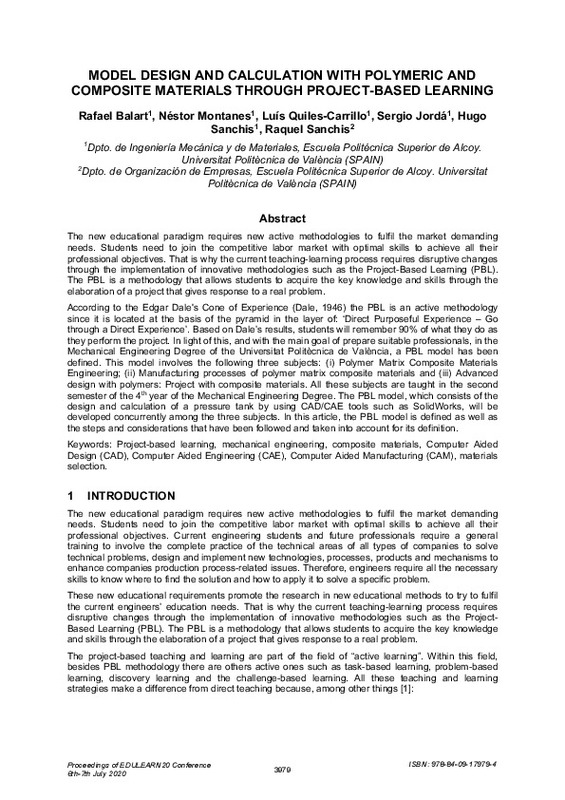JavaScript is disabled for your browser. Some features of this site may not work without it.
Buscar en RiuNet
Listar
Mi cuenta
Estadísticas
Ayuda RiuNet
Admin. UPV
Model Design and Calculation with Polymeric and Composite Materials through Project-Based Learning
Mostrar el registro sencillo del ítem
Ficheros en el ítem
| dc.contributor.author | Balart, Rafael
|
es_ES |
| dc.contributor.author | Montanes, Nestor
|
es_ES |
| dc.contributor.author | Quiles-Carrillo, Luis
|
es_ES |
| dc.contributor.author | Jordá-Gisbert, Sergio
|
es_ES |
| dc.contributor.author | Sanchis-Gomis, Hugo Carlos
|
es_ES |
| dc.contributor.author | Sanchis, R.
|
es_ES |
| dc.date.accessioned | 2021-01-20T04:31:44Z | |
| dc.date.available | 2021-01-20T04:31:44Z | |
| dc.date.issued | 2020 | es_ES |
| dc.identifier.uri | http://hdl.handle.net/10251/159519 | |
| dc.description.abstract | [EN] The new educational paradigm requires new active methodologies to fulfil the market demanding needs. Students need to join the competitive labor market with optimal skills to achieve all their professional objectives. That is why the current teaching-learning process requires disruptive changes through the implementation of innovative methodologies such as the Project-Based Learning (PBL). The PBL is a methodology that allows students to acquire the key knowledge and skills through the elaboration of a project that gives response to a real problem. According to the Edgar Dale's Cone of Experience (Dale, 1946) the PBL is an active methodology since it is located at the basis of the pyramid in the layer of: `Direct Purposeful Experience ¿ Go through a Direct Experience¿. Based on Dale¿s results, students will remember 90% of what they do as they perform the project. In light of this, and with the main goal of prepare suitable professionals, in the Mechanical Engineering Degree of the Universitat Politècnica de València, a PBL model has been defined. This model involves the following three subjects: (i) Polymer Matrix Composite Materials Engineering; (ii) Manufacturing processes of polymer matrix composite materials and (iii) Advanced design with polymers: Project with composite materials. All these subjects are taught in the second semester of the 4th year of the Mechanical Engineering Degree. The PBL model, which consists of the design and calculation of a pressure tank by using CAD/CAE tools such as SolidWorks, will be developed concurrently among the three subjects. In this article, the PBL model is defined as well as the steps and considerations that have been followed and taken into account for its definition. | es_ES |
| dc.description.sponsorship | This article has been supported by the Vice-rectorate for Digital Resources and Documentation (Vicerrectorado de Recursos Digitales y Documentación) and Vice-Rectorate for Studies, Quality and Accreditation (Vicerrectorado de Estudios, Calidad y Acreditación) under the Call for Learning + Teaching (Convocatoria Aprendizaje + Docencia (A+D 2019)) and Project Code: 1678-A. The authors would like to acknowledge the support of the Institute of Educational Sciences (Instituto de Ciencias de la Educación) of Universitat Politècnica de València, the Evaluation and Monitoring Commission for Educational Innovation and Improvement Projects (Comisión de Evaluación y Seguimiento de Proyectos de Innovación y Mejora Educativa (CESPIME)) and Escuela Politécnica Superior de Alcoy | es_ES |
| dc.language | Inglés | es_ES |
| dc.publisher | IATED, International Association of Technology, Education and Development | es_ES |
| dc.relation.ispartof | EDULEARN Proceedings (Internet) | es_ES |
| dc.relation.ispartof | EDULEARN20 Proceedings | es_ES |
| dc.rights | Reserva de todos los derechos | es_ES |
| dc.subject | Project-based learning | es_ES |
| dc.subject | Mechanical engineering | es_ES |
| dc.subject | Composite materials | es_ES |
| dc.subject | Computer Aided Design (CAD) | es_ES |
| dc.subject | Computer Aided Engineering (CAE) | es_ES |
| dc.subject | Computer Aided Manufacturing (CAM) | es_ES |
| dc.subject | Materials selection | es_ES |
| dc.subject.classification | INGENIERIA MECANICA | es_ES |
| dc.subject.classification | INGENIERIA DE LOS PROCESOS DE FABRICACION | es_ES |
| dc.subject.classification | CIENCIA DE LOS MATERIALES E INGENIERIA METALURGICA | es_ES |
| dc.subject.classification | ORGANIZACION DE EMPRESAS | es_ES |
| dc.title | Model Design and Calculation with Polymeric and Composite Materials through Project-Based Learning | es_ES |
| dc.type | Artículo | es_ES |
| dc.type | Comunicación en congreso | es_ES |
| dc.type | Capítulo de libro | es_ES |
| dc.identifier.doi | 10.21125/edulearn.2020.1076 | es_ES |
| dc.rights.accessRights | Abierto | es_ES |
| dc.contributor.affiliation | Universitat Politècnica de València. Instituto de Tecnología de Materiales - Institut de Tecnologia de Materials | es_ES |
| dc.contributor.affiliation | Universitat Politècnica de València. Departamento de Organización de Empresas - Departament d'Organització d'Empreses | es_ES |
| dc.contributor.affiliation | Universitat Politècnica de València. Departamento de Ingeniería Mecánica y de Materiales - Departament d'Enginyeria Mecànica i de Materials | es_ES |
| dc.description.bibliographicCitation | Balart, R.; Montanes, N.; Quiles-Carrillo, L.; Jordá-Gisbert, S.; Sanchis-Gomis, HC.; Sanchis, R. (2020). Model Design and Calculation with Polymeric and Composite Materials through Project-Based Learning. EDULEARN Proceedings (Internet). 3979-3986. https://doi.org/10.21125/edulearn.2020.1076 | es_ES |
| dc.description.accrualMethod | S | es_ES |
| dc.relation.conferencename | 12th International Conference on Education and New Learning Technologies (EDULEARN 2020) | es_ES |
| dc.relation.conferencedate | Julio 06-07,2020 | es_ES |
| dc.relation.conferenceplace | Online | es_ES |
| dc.relation.publisherversion | https://doi.org/10.21125/edulearn.2020.1076 | es_ES |
| dc.description.upvformatpinicio | 3979 | es_ES |
| dc.description.upvformatpfin | 3986 | es_ES |
| dc.type.version | info:eu-repo/semantics/publishedVersion | es_ES |
| dc.identifier.eissn | 2340-1117 | es_ES |
| dc.relation.pasarela | S\415359 | es_ES |
| dc.contributor.funder | Universitat Politècnica de València | es_ES |








